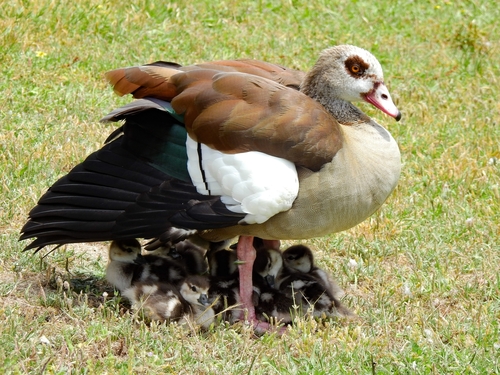
Egyptian Goose
The Egyptian Goose (Alopochen aegyptiaca) is a striking member of the duck, goose, and swan family Anatidae, native to Africa south of the Sahara and the Nile Valley. Despite its name, it's more closely related to shelducks than true geese. Prized in ancient Egypt and considered sacred, this bird is now widespread and often found in open grasslands, wetlands, and even urban parks. It plays an important ecological role as a grazer and seed disperser, influencing plant communities in its range. It holds cultural significance, having been depicted in ancient Egyptian art and sometimes kept as an ornamental bird.
63-73 cm
Length
110-135 cm
Wingspan
Least Concern
Conservation Status
Distribution
Primarily found in Africa south of the Sahara, including the Nile River Valley. Populations have also been introduced and become established in parts of Europe (notably Great Britain, the Netherlands, and Belgium) and North America (Florida). It is not a highly migratory species, though some populations make local movements in response to rainfall and food availability.
Lifespan
Up to 15 years in the wild, potentially longer in captivity.
Egyptian Goose's Habitat
Habitat Types
Grasslands, Wetlands, Lakes, Rivers, Agricultural fields, Urban parks
Climate Zones
Tropical, Subtropical, Temperate
Adaptations
The Egyptian Goose is highly adaptable, thriving in a wide variety of habitats. Its broad diet and ability to utilize both natural and human-modified landscapes contribute to its success. Their strong legs and slightly upright posture allow for efficient walking and grazing on land.
Variations
No recognized subspecies exist, although there may be slight regional variations in size and plumage coloration.
Appearance
Breeding Plumage
Plumage is largely consistent year-round, with no distinct breeding plumage.
Seasonal Feather Changes
Minor seasonal variations may occur due to feather wear and molting.
Sex Based Plumage Differences
Sexes are similar in plumage, though males may have slightly more intense coloration.
Notable Features
Distinctive brown eye patch., Pale brown head and neck., Pinkish legs and bill., White wing patches visible in flight.
Diet and Feeding
Primary Foods
Grasses, Seeds, Leaves, Crops (e.g., wheat, maize), Aquatic plants
Foraging Behavior
Primarily grazes on land, similar to geese. It also dabbles in shallow water for aquatic plants and invertebrates. Often feeds in groups, particularly in agricultural areas.
Specializations
Its strong bill is well-suited for grazing and tearing vegetation. The slightly serrated edges of the bill aid in gripping and processing plant material.
Seasonal Diet Variations
Diet can vary depending on the availability of food resources. In some areas, they may rely more heavily on crops during certain times of the year.
Behavior
Social Structure
Forms pairs or small family groups. Outside of the breeding season, they may gather in larger flocks, especially at feeding and roosting sites.
Communication
Loud honking calls, Hissing sounds (when threatened), Visual displays (e.g., head-bobbing, wing-flapping)
Migration
Generally non-migratory, but some populations undertake local movements in response to water availability and food resources.
Territorial or Group Behaviors
Highly territorial during the breeding season, aggressively defending their nesting site from intruders, including other Egyptian Geese and potential predators. Outside of breeding, they are more gregarious.
Conservation
Threats
Habitat loss (due to agriculture and urbanization), Hunting (in some regions), Pesticide exposure, Competition with introduced species
Protection Programs
General wildlife protection laws in many countries., Habitat restoration projects in some areas.
Local National Laws
Protected under various national wildlife laws across its range. In some introduced areas, it may be considered an invasive species and subject to control measures.
Population Trend
Stable
Population Estimates
Global population estimated to be in the hundreds of thousands to millions.
Interesting Facts
They were considered sacred by the ancient Egyptians.
Frequently depicted in ancient Egyptian art and sometimes mummified.
They can be quite aggressive.
Known to fiercely defend their nests and young, even attacking much larger animals.
They are strong fliers.
Despite their terrestrial habits, they are capable of strong, sustained flight.
They are known to hybridize with other shelduck species.
This can occur in areas where their ranges overlap, particularly in introduced populations.
Faqs about Egyptian Goose
Are Egyptian Geese really geese?
No, they are more closely related to shelducks, although they share some characteristics with true geese.
Why are they found outside of Africa?
They have been introduced to various parts of the world, often as ornamental birds, and have established feral populations.
Are they good to eat?
While they are edible, they are not typically considered a prime game bird. Their meat can be tough, and they are often protected by law.
Are they invasive?
In areas outside their native range. They can be considered invasive and can have the potential to compete with native species.
Copyright @ Nature Style Limited. All Rights Reserved.
 English
English